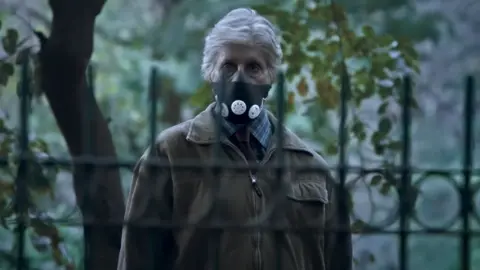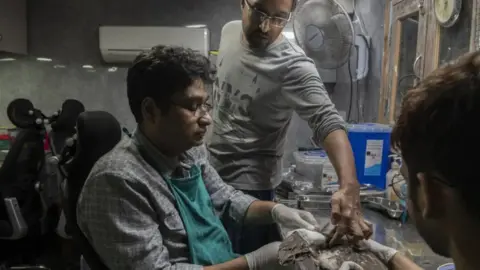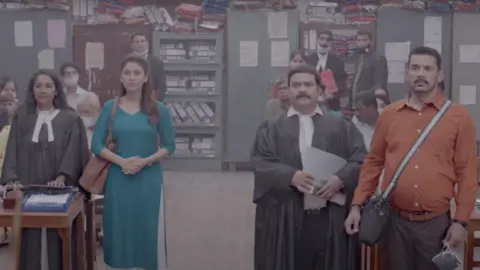Physical Address
304 North Cardinal St.
Dorchester Center, MA 02124
Physical Address
304 North Cardinal St.
Dorchester Center, MA 02124

 A screenshot from the Pink trailer
A screenshot from the Pink trailerIn the 2016 Bollywood hit Pink, the scene introducing Amitabh Bachchan’s character shows the actor coming out of his house on a winter morning in the smog-filled streets of Delhi wearing a mask.
The mask and the smoky air of Delhi are seen in other scenes of the film, but play little role in its plot.
However, this is one of the rare examples of a mainstream Indian film taking into account the deadly air that plagues many parts of India. dangerous to live every year.
Toxic air pollution and recurring winter smog in Delhi and other parts of India’s capital city in northern India often make headlines, becoming the subject of public concern, political debate and legal condemnation. But unlike disasters like the devastating floods in Uttarakhand in 2013, Kerala in 2018 and the city of Mumbai in 2005, each of which have inspired films, air pollution has been largely absent from Indian pop culture.
Siddharth Singh, author of The Great Smog of India, a book on pollution, says it is a “huge failure” that air pollution is not the dominant story in Indian literature and filmmaking.
He points out that much of the literature on pollution in India remains in the domain of academia and scientific knowledge.
“When you say PM2.5 or NOx or SO2 (all pollutants), what are those words? They mean nothing to (ordinary) people.”
In his 2016 book The Great Derangement, author Amitav Ghosh, who has written extensively on climate change, observed that contemporary fiction lacks such stories.
“People are strangely normal about climate change,” he said In the 2022 interview.
The writer described being in India during a heat wave.
“I was struck by the fact that everything seemed normal, and that was the most worrying thing,” he said. “It seems that we have already learned to live with these changes.”
Ghosh described climate change as a “slow violence” that made writing difficult.
This is certainly true of pollution – it can have devastating health effects over a long period of time, but it doesn’t lend itself to dramatic visuals.
 Saumya Handelwala
Saumya HandelwalaHowever, this topic has been explored in documentaries such as Shaunak Sen Everything that breatheswhich was nominated for an Oscar in 2022.
Sen explored climate change, pollution and the nature of human-animal relationships in Delhi’s ecosystem through the story of two brothers who treated injured black dragons that fell from the city’s smoky skies.
Sen says he was interested in exploring how “something as big as the Anthropocene” (a term used to describe the current moment in which humans are having a major impact on the living and physical world) or climate change is tied to small quibbles. and everyday irritability.
The film shows the two brothers arguing. One of them then points to the sky and to himself and says, “Yeh sab jo hamare beech mein ho raha hai, you is sab ki galti hai (What is happening between us is all this fault).”
“(The effects of climate change) actually permeate every aspect of our lives,” Sen says. “And the task of representation, whether it’s cinema or literature, is to give it that robustness in its representation.”
He says environmental films that are pedantic, prescriptive or hold the audience by the collar to make them feel bad do more disservice than good.
“I think the best movies are the ones that are Trojan horses that are able to draw ideas without the audience being fully aware that they’re engaging in that conversation.”
Filmmaker Nila Madhab Panda, whose work on climate change and the environment spans over 70 films, believes art can make a difference.
Panda, who began telling stories about climate change in 2005 with his documentary Climate’s First Orphan, turned to more mainstream cinema to reach a wider audience.
 Nila Madhab Panda
Nila Madhab PandaThe filmmaker was born and brought up in Kalahandi Balangir Koraput region of the drought and flood prone eastern state of Odisha and moved to Delhi in 1995.
“It’s amazing to me that I live in an ecosystem where you see four seasons, you drink water straight from the river. We have natural resources for free – air, water, fire, everything. And I end up in Delhi, where you buy everything. Buy water, buy air. Each room has an air filter.”
In 2019, Panda made a short film for an anthology where he explored the topic of pollution in Delhi through the courtroom drama of a divorce because they couldn’t agree on whether to proceed. lives in the capital.
“You can’t just make something that isn’t entertaining and show (it),” Panda says.
Creators also take on the challenge of humanizing complex stories.
Singh, whose 2018 book examines India’s air pollution crisis, says he struggled to find the people behind the statistics while writing it.
“We always read these headlines about the million or two million people who die every year because of pollution. But where are these people? Where are their stories?”
 Getty Images
Getty ImagesWhile environmental themes have often found a place in India’s vast canon of regional literature, many contemporary English writers, including Ghosh, have also highlighted the theme – the Bhalswa garbage dump in Delhi features in Nilanjan S Roy’s crime novel Black River. In Gigi Ganguly’s Biopeculiar and Janice Pariat’s All That the Light Touches, the writers explore our relationship with the natural environment.
But there is still a long way to go.
Singh says one reason for the relative dearth of such stories could be that the people making them are “insulated” by their privilege.
“It is not the people on the banks of the (polluted) Yamuna river who see a poem in it or write about the stories on its banks.”
Memes and photos on social media have been most effective in capturing the severity of air pollution these days, he says.
“A meme that was trending a few days ago said something like, ‘Sheikh Hasina (Bangladesh Prime Minister in exile, now in Delhi) spotted on her daily morning walk’. But the attached picture was all gray because the joke was that he couldn’t be seen due to air pollution!
The writer hopes that such creative opportunities will find enough momentum to eventually “elicit a response from those who can really make a difference.”
“I think that’s what we’re missing right now,” he says.
Follow BBC News India Instagram, YouTube, Twitter and Facebook.